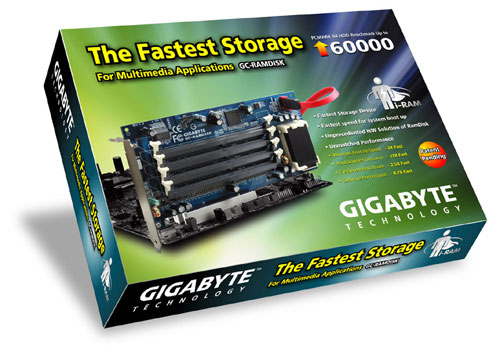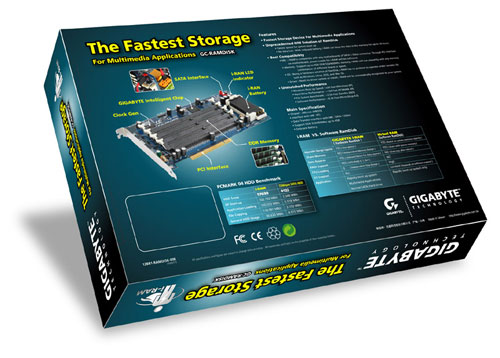Gigabyte's i-RAM: Affordable Solid State Storage
by Anand Lal Shimpi on July 25, 2005 3:50 PM EST- Posted in
- Storage
For years now, motherboard manufacturers have been struggling to find other markets to branch out to, in an attempt to diversify themselves, preparing for inevitable consolidation in the market. Every year at Computex, we'd hear more and more about how the motherboard business was getting tougher and we'd see more and more non-motherboard products from these manufacturers. For the most part, the non-motherboard products weren't anything special. Everyone went into making servers, then multimedia products, then cases, networking, security, water cooling; the list goes on and on.
This year's Computex wasn't very different, except for one thing. When Gigabyte showed us their collection of goodies for the new year, we were actually quite interested in one of them. And after we posted an article about it, we found that quite a few of you were very interested in it too. Gigabyte's i-RAM was an immediate success and it wasn't so much that the product was a success, but it was the idea that piqued everyone's interests.
Pretty much every time a faster CPU is released, we always hear from a group of users who are marveled by the rate at which CPUs get faster, but loathe the sluggish rate that storage evolves. We've been stuck with hard disks for decades now, and although the thought of eventually migrating to solid state storage has always been there, it's always been so very distant. These days, you can easily get a multi-gigabyte solid state drive if you're willing to spend the tens of thousands of dollars it costs to get one; prices actually vary from the low $1000s to the $100K range for solid state devices, obviously making them impractical for desktop users.
The performance benefits of solid state storage have always been tempting. With no moving parts, reliability is improved tremendously, and at the same time, random accesses are no longer limited by slow and difficult to position read/write heads. While sequential transfer rates have improved tremendously over the past 5 years, thanks to ever increasing platter densities among other improvements, it is the incredibly high latency that makes random accesses very expensive from a performance standpoint for conventional hard disks. A huge reduction in random access latency and increase in peak bandwidth are clear performance advantages to solid state storage, but until now, they both came at a very high price.
The other issue with solid state storage is that DRAM is volatile, meaning that as soon as power is removed from the drive, all of your data would be lost. More expensive solutions get around this by using a combination of a battery backup as well as a hard disk that keeps a backup of all data written to the solid state drive, just in case the battery or main power should fail.
Recognizing the allure of solid state storage, especially to performance-conscious enthusiast users, Gigabyte went about creating the first affordable solid state storage device, and they called it i-RAM.
Through some custom logic, the i-RAM works and acts just like a regular SATA hard drive. But how much of a performance increase is there for desktop users? And is the i-RAM worth its still fairly high cost of entry? We've spent the past week trying to find out...
This year's Computex wasn't very different, except for one thing. When Gigabyte showed us their collection of goodies for the new year, we were actually quite interested in one of them. And after we posted an article about it, we found that quite a few of you were very interested in it too. Gigabyte's i-RAM was an immediate success and it wasn't so much that the product was a success, but it was the idea that piqued everyone's interests.
Pretty much every time a faster CPU is released, we always hear from a group of users who are marveled by the rate at which CPUs get faster, but loathe the sluggish rate that storage evolves. We've been stuck with hard disks for decades now, and although the thought of eventually migrating to solid state storage has always been there, it's always been so very distant. These days, you can easily get a multi-gigabyte solid state drive if you're willing to spend the tens of thousands of dollars it costs to get one; prices actually vary from the low $1000s to the $100K range for solid state devices, obviously making them impractical for desktop users.
The performance benefits of solid state storage have always been tempting. With no moving parts, reliability is improved tremendously, and at the same time, random accesses are no longer limited by slow and difficult to position read/write heads. While sequential transfer rates have improved tremendously over the past 5 years, thanks to ever increasing platter densities among other improvements, it is the incredibly high latency that makes random accesses very expensive from a performance standpoint for conventional hard disks. A huge reduction in random access latency and increase in peak bandwidth are clear performance advantages to solid state storage, but until now, they both came at a very high price.
The other issue with solid state storage is that DRAM is volatile, meaning that as soon as power is removed from the drive, all of your data would be lost. More expensive solutions get around this by using a combination of a battery backup as well as a hard disk that keeps a backup of all data written to the solid state drive, just in case the battery or main power should fail.
Recognizing the allure of solid state storage, especially to performance-conscious enthusiast users, Gigabyte went about creating the first affordable solid state storage device, and they called it i-RAM.



Through some custom logic, the i-RAM works and acts just like a regular SATA hard drive. But how much of a performance increase is there for desktop users? And is the i-RAM worth its still fairly high cost of entry? We've spent the past week trying to find out...










133 Comments
View All Comments
simpletech - Tuesday, July 26, 2005 - link
I think another possible use (besides certain kinds of servers, like mail servers), is for video capture. The size is a bit small, but if you were capturing segments of footage, it might work. And the price could be reasonable.BikeDude - Tuesday, July 26, 2005 - link
"but 32-bit Windows can't use more than 4GB of RAM, including the swap file size."First of all... "Swap file" is a misnomer. We talked about "swap file" back in the Windows 3.1 days when the OS would swap a process' entire memory space to the *swap* file.
These days the OS will read/write selected pages of a process' memory from/to the cache manager (who may or may not elect to use the disk to get to the physical pagefile). *Paging*, not "swapping". Executables and libraries are memory mapped and thus start their lives with all pages firmly on disk (so a big executable won't necessarily load slow, but many small DLLs OTOH just might).
I don't have Windows XP in front of me, but my 32-bit Windows 2003 Standard ed. with 4GB memory and 1GB pagefile certainly doesn't seem affected by the limitation you mention. Enterprise edition can address even more physical memory... Each process is still limited to a 2GB virtual address space though. (32-bit processes marked capable of such will gain a 4GB virtual address space under 64-bit Windows)
I realise that XPSP2, despite PAE, is limited to 4GB physical memory (http://blogs.msdn.com/carmencr/archive/2004/08/06/...">http://blogs.msdn.com/carmencr/archive/2004/08/06/..., but pagefile as well? Nah, sounds iffy.
JarredWalton - Tuesday, July 26, 2005 - link
Without PAE (or something similar), 32-bit OSes are indeed limited to 4GB of RAM. This is what is being referred to, as PAE is limited to Intel and I don't believe it's available on non-Server versions of Windows. (Correct me if I'm wrong, but PAE is pretty much only on Xeons, right?)You're right that it's paging instead of swapping now, but there's really not much difference between the two. Basically, you put data onto the HDD in order to free up physical RAM, on the assumption that the least recently used data that was moved to the HDD won't be accessed again for a while.
JarredWalton - Tuesday, July 26, 2005 - link
Anyway, I've modified the comment to reflect the original intent. If you're running PAE and Server, it's a whole different ball game for high memory systems.Penth - Tuesday, July 26, 2005 - link
Wow, my friend and I talked about the possibilities for these things several times. But at 3x the initial price and not the performance increase I would have expected, the techie in me is disappointed. My wallet is happy though.StanleyBuchanan - Tuesday, July 26, 2005 - link
I wonder what the issue is with RAID that Anand comments on.... seems odd that it would behave differently than a HD in this respect and cause problems...I would love to have 12gb or more... which is enough for Windows XP, a productivity suite, and a modern game... anything more could be run from NAS
Zan Lynx - Sunday, July 31, 2005 - link
Probably something to do with the PCI bus power. Perhaps two of these cards take more juice than the bus expects to provide while on standby.phaxmohdem - Monday, July 25, 2005 - link
I saw someone else posting as well, but I would very much like to see some database performance numbers from this device, as well as perhaps a web-serving benchmark.xTYBALTx - Monday, July 25, 2005 - link
How some FPS benchies?GTMan - Monday, July 25, 2005 - link
I laughed when I saw that line :) A very interesting device and I look forward to where this goes in the future. Your "Final Words" could use a bit of brevity.